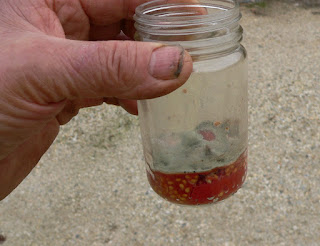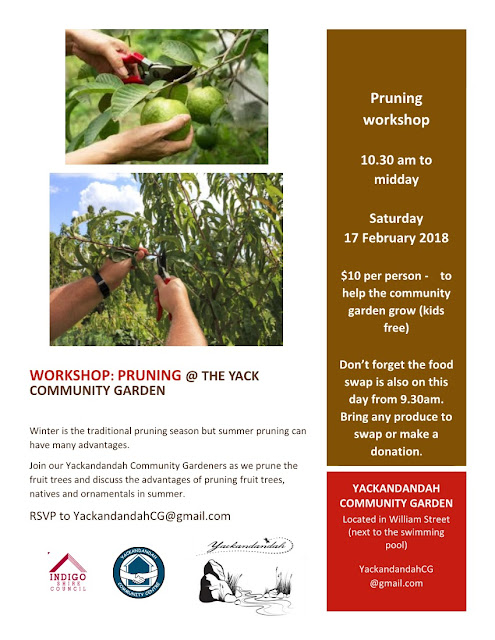Lee-Anne brought a couple of tomatoes along to the Yackandandah Community Garden. They are from a cherry tomato which she considers is a very nice variety and suits her needs extremely well so she is keen to keep growing the same type each year.
So far it has successfully self seeded in her garden each year so there's been no need to replant but she is worried that one year something will happen and no volunteers will pop up. That's how good this tomato is for her.
The solution is to keep some seeds from a couple of healthy fruit from a plant that is typical of the variety. That way, if the unthinkable happens and no volunteer seedlings turn up one year she will at least be able to grow the same type from seed she has saved.
That brings me back to those tomatoes she brought to the garden. What's the best way to collect and store the seed for future planting?
The simplest way to save tomato seed is to squeeze the seeds and juice out of a ripe fruit onto some paper (paper towel or tissue paper is good but newspaper will do) and spread the seeds out thinly. Sit it in a warm, dry place for a few days until the pulp has dried. The seeds will be glued quite well to the paper so just roll up the paper with seeds and store in a sealed container. Make sure you label the seeds or the container. Even if you have a good memory in 12 months or a couple of years you'll find the container and wonder what the stained piece of paper is about. Add the date so that you will be able to keep track of how old the seeds are. Tomato seed is generally viable for around 5 years but I have had some that germinated well after 8 years so these seeds will be good for a long time.
When the time comes to plant just tear the paper up into small pieces and plant the seeds paper and all.
One possible problem with storing tomato seed like this is that any diseases that are in your tomato this year will still be present in the dried pulp surrounding the seeds so when you plant it your young seedlings can be infected right from the start.
A better alternative for tomatoes and other soft fruits is to ferment the pulp. Fermenting helps to dissolve the fruit and may even kill some diseases.
Squash the fruit into a container. Here I've used a glass jar but a plastic container is just as good. If the tomato has little pulp or flesh you can add just a little water.
Don't add too much water at this stage. It appears that tomato fruit have some chemicals that inhibit the seeds from germinating. Water dilutes these chemicals and leaches them away until the seed can grow. I think that's an impressive adaptation. Seeds won't grow inside the juicy fruit and, even when the fruit has fallen on the ground it takes some time for the chemicals to disperse so the seeds won't even try to grow for several months and by then it is spring again. A very neat trick to make sure the tomato babies are safe from the winter cold.
Leave the container of tomato pulp and seeds uncovered in a warm place. After a few days the pulp should start to go mouldy - that's good. The bacteria and fungi are breaking down the tomato flesh and cleaning your seeds. If it dries out just add a little more water to keep the pulp just liquid.
After 4-6 days it is time to rinse the seeds.
Pour the mouldy pulp into a kitchen sieve and rinse under a tap our outside with a hose.
All the softened pulp should wash away but you may need to assist by rubbing the softened pulp with your fingers. It should take just a couple of minutes to clean the seeds.
Shake off excess water then turn the sieve upside down over a sheet of newspaper and tap the sieve to transfer the seeds to the paper.
Leave the paper in a warm place for a few days until the mass of seed is dry They will usually stick together but when properly dry just rub between the fingers to separate the seeds.
Store in an airtight container, label with the type and date for future reference and keep in a cool, dark place to keep them viable for years.
If you're growing a really nice tomato variety why not keep some seeds for next year or to give away to friends. I've found this treatment ideal for both tomato and cucumber seeds.
Happy seed saving










